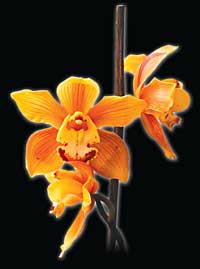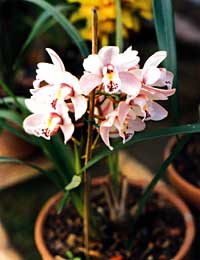 There is something about orchids that makes crazed enthusiasts travel thousands of miles for a single picture. No other flower evokes such passion.
There is something about orchids that makes crazed enthusiasts travel thousands of miles for a single picture. No other flower evokes such passion. Some orchids are so coveted that collectors have carried out spectacular heists of rare specimens.
Nepal is a paradise for orchids, the moist climate and the cloud forest environment is ideal for them. That also makes Nepal a paradise for orchid smugglers. In the 1980s, according to one estimate, up to 100 lorries of dried Nepali orchids plundered from our forests were lined up ready to head south.
Now, Nepal's orchid experts and enthusiasts are working to save this national treasure. And their fascination with the fancy flower also has financial benefits.
Bharat Rai and his partner Kabiraj Rai started up an orchid farm in Godavari as a way to keep busy after retirement. Their farm, Rai's Orchid, has been producing potted hybrid orchids and cut flowers commercially since 2002. Bharat Rai handles the management and logistics, but orchids are actually Kabiraj Rai's passion turned commercial venture. And he loves telling us how it's done.
"Orchids are propagated in three ways: from pseudobulbs, through plant division and tissue cultures," he explains. In pseudo- bulb propagation, orchid bulbs give off one, sometimes even two, shoots. Once the shoots are a year old, the back bulbs can be removed to begin another plant. The little plant is still another two to three years from flowering. But if one pot contains several bulbs along with their shoots, an alternative is plant division. After the orchid blooms, back bulbs, each along with one shoot, can be separated and replanted. However, Rai prefers to work with tissue cultures.
In nature, orchid seedpods burst open, releasing hundreds of thousands of seeds in a powdered explosion. Only five or six survive and mature. Tissue cultures enable more production, and this is the process biologist Brajesh Vaidya and his team at Nepal Biotech Nursery (nbn) specialise in. There isn't much that can be done to speed up the process even in lab conditions. "Anyone getting into the orchid business is in it for the long haul," says Vaidya.
 In the lab, the contents of the seedpods are put in a chemical. The individual bottles are set under 12 hours of lighting and in perfect humidity. There they go through six stages of growth before reaching the rooted stage. But if we're talking from seedpod to flowering, even a tissue culture will take four to five years. Vaidya's nbn has been exporting tissue cultures of indigenous orchids to Japan and Europe. Hybrid cultures are sold to local growers, numbering only five or six in the Valley, who grow for the local market. "South Asians seem to prefer the bright colours of hybrids for decoration while Europeans go more for the earthy tones of indigenous varieties," notes Vaidya. Orchid export is regulated by the Convention on International Trade in Endangered Species (CITES), which requires that all orchids being exported have been propagated by tissue culture.
In the lab, the contents of the seedpods are put in a chemical. The individual bottles are set under 12 hours of lighting and in perfect humidity. There they go through six stages of growth before reaching the rooted stage. But if we're talking from seedpod to flowering, even a tissue culture will take four to five years. Vaidya's nbn has been exporting tissue cultures of indigenous orchids to Japan and Europe. Hybrid cultures are sold to local growers, numbering only five or six in the Valley, who grow for the local market. "South Asians seem to prefer the bright colours of hybrids for decoration while Europeans go more for the earthy tones of indigenous varieties," notes Vaidya. Orchid export is regulated by the Convention on International Trade in Endangered Species (CITES), which requires that all orchids being exported have been propagated by tissue culture. Unfortunately, orchid smuggling is still not under control. Trafficking indigenous wild orchids is easy and truck loads are smuggled into India where false certificates are obtained for export to Europe and the US as artificially propagated plants. "If someone goes into the forest and picks an orchid for themselves, it's not such a big problem. The problem arises when someone goes into the forest, sees a beautiful orchid and then hires people to pick them by the truck loads," says Vaidya.
Nepal is home to 386 recorded varieties of orchids, and three or four more species are found every year. There are eight endemic species of orchids, found only in Nepal.
Meeting the international demands for our indigenous orchids by exporting their tissue cultures is one way to address rampant illegal export. It also makes great business sense. Orchids, once cut, last six to eight weeks in the right conditions. Cool, well-ventilated rooms with indirect light are ideal. It's a lucrative venture: one orchid stick can cost Rs 50-150, while a single rose sells for Rs 20. Rai's Orchid can't seem to keep up with the demand, even with orchid production growing by 25 percent a year.
 "We want to encourage and support more people to start orchid farms. This is the best time of year for training, from January to end of March, when the orchids bloom and we harvest them," says Kabiraj who also teaches propagation techniques. There are no secrets here, Kabiraj readily gives away the formula for the soil: 60 percent cow dung and peat to the rest charcoal bits, brick chips, sand and coconut husk.
"We want to encourage and support more people to start orchid farms. This is the best time of year for training, from January to end of March, when the orchids bloom and we harvest them," says Kabiraj who also teaches propagation techniques. There are no secrets here, Kabiraj readily gives away the formula for the soil: 60 percent cow dung and peat to the rest charcoal bits, brick chips, sand and coconut husk. It may be taking coals to Newcastle, but in the future Rai's Orchid plans to export orchids to Thailand, Singapore and Malaysia. These are countries famous for tropical orchids, but our colourful hybrid Cymbidiums add variety and are in high demand. There is also a growing market for cut flowers in the Middle East but these require more investment for chilling rooms at customs and proper packaging.
With a growing local demand for orchids, Rai's Orchid is gearing up to address the market. Last week, the Rai duo were poring over a bunch of Golden Gull Cymbidiums in full bloom at their Godavari farm. It's obvious that the end result has made it well worth the wait. For Kabiraj, the farm has become his life's mission. Leaning back in his lawn chair, he adds, "It's a tension-free occupation, perfect for retired life. We're independent, keep busy and it's good exercise."
Flower power
Traditionally Nepalis used flowers only for pujas. As urban incomes rise, more and more people are displaying flower arrangements and presenting flowers on special occasions.
Suman Pradhan has been running Chameli, a family-owned flower shop in Jhamsikhel since the early 1990s. He started with just a couple buckets of cut flowers on the sidewalk. The lovely lilies and fragrant roses generated interest, so he set out more buckets. Today, they're a full-fledged flower supermarket.
Today, Pradhan's daily income from cut flowers alone ranges from Rs 3,000 on slow days to Rs 40,000 on special occasions like Valentine's or Mother's Day. And orchids, when they're in, are best sellers. The only problem, says Pradhan, is that there is no regular supply of orchids.
When we asked him what needs to happen to boost the business in floriculture, Pradhan had a thing or two to say: "FAN needs to be more effective. The wholesale they recently opened has benefited us. But we are working at a very unstable market. Competition is increasing, but it's not guided by specific rules and regulations. People are not competing on the basis of service, but price alone."
Another trend that has changed is the amount of flowers imported from India to meet our local demand. "Previously, all our flowers used to come from Delhi, Calcutta or Bangalore. Today, all our summer flowers are grown here and we only import Indian flowers in winter," says Pradhan.
At the end of another day's work this week, Pradhan is doing an inventory of flowers and is pleased with sales. "Previously it seemed only the upper class or tourists bought flowers. Now the middle class are giving flowers for all occasions like when a baby is born, or to someone who's feeling sick."
And why not? After all, scientific research show that just having flowers around triggers happy emotions, helps us feel more satisfied with life and encourages positive social behaviour. Pradhan says with a knowing smile: "People are beginning to appreciate flower power." (Sraddha Basnyat)
Floral tributes
From agriculture to floriculture at FAN 2004
 The organisers at Floriculture Association Nepal (FAN) are getting ready for Floriculture Exhibition 2004, an annual event plant and flower lovers across the Valley are waiting for. This is where those in the cut flower and nursery business, those interested in landscaping and the gardener in each of us, can all go to see what's new and in bloom from seasonal to ornamental, indoor to outdoor, tissue cultures to fruit bearing alike.
The organisers at Floriculture Association Nepal (FAN) are getting ready for Floriculture Exhibition 2004, an annual event plant and flower lovers across the Valley are waiting for. This is where those in the cut flower and nursery business, those interested in landscaping and the gardener in each of us, can all go to see what's new and in bloom from seasonal to ornamental, indoor to outdoor, tissue cultures to fruit bearing alike. "Last year we had 54 stalls and we're hoping for more participants this year," says FAN President Minerwa Bista. In the past participants from as far and wide as Janakpur, Pokhara, Dharan and Butwol would eagerly arrive at the national exhibition. But due to the security situation, Bista expects fewer participants this year. She adds, "Plants are perishable and people don't want to risk losing their hard work when they get stuck for hours in security checks."
"But there is good business in floriculture." admits Bista, herself the proprietor of a cut flower nursery in Kathmandu. In 2002-2003, the cut flowers was a Rs 23,730,000 business, while the nurseries together brought in over Rs 54 million. To boost the floriculture sector, FAN organises regular technical trainings in pest control, gardening, bouquet arrangement and seasonal flower management workshops. Says Bista, "Five or six years ago, Nepal imported 80 percent of our flowers from India. Now we grow about 85 percent and import 15 to 20 percent, which is during the off season. In a year or two we should be able to grow enough all our own."
(Sradhha Basnyat)


